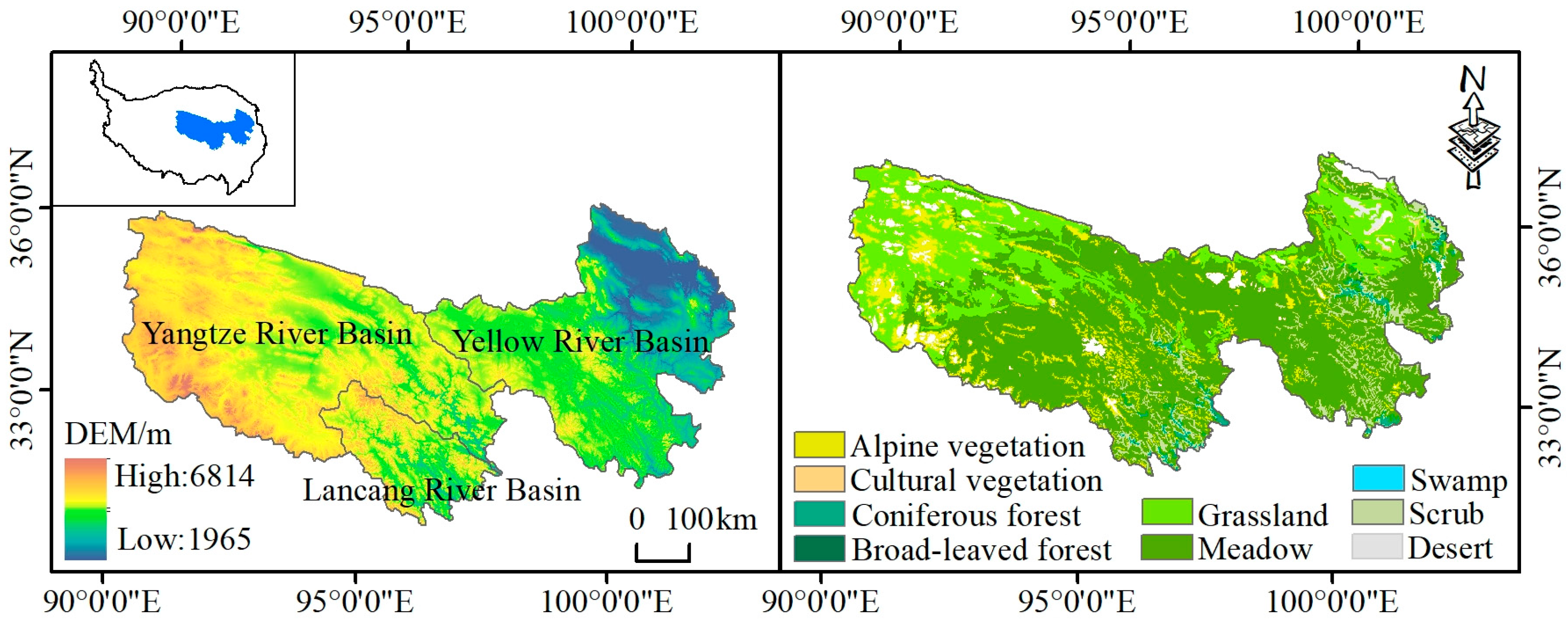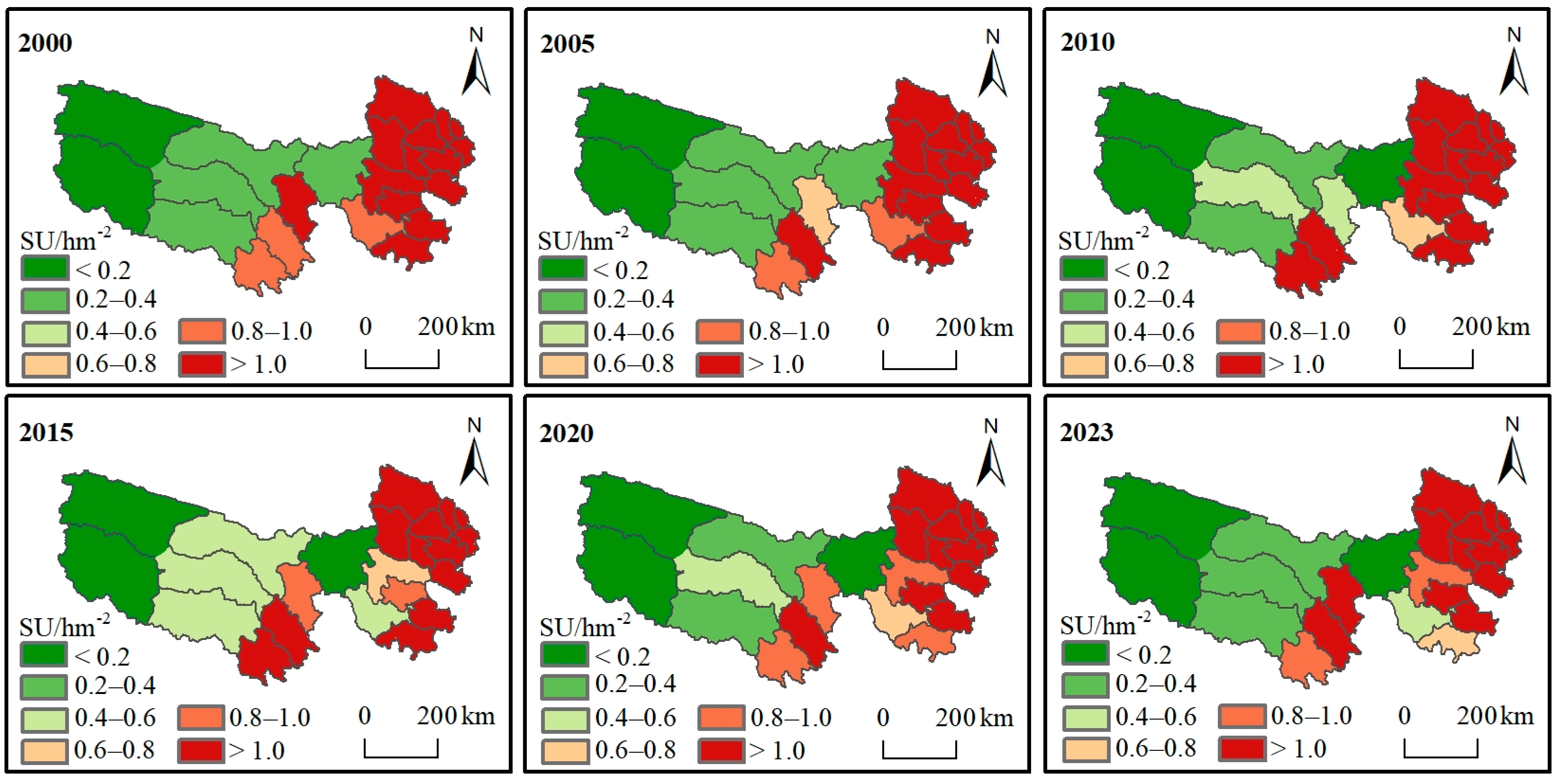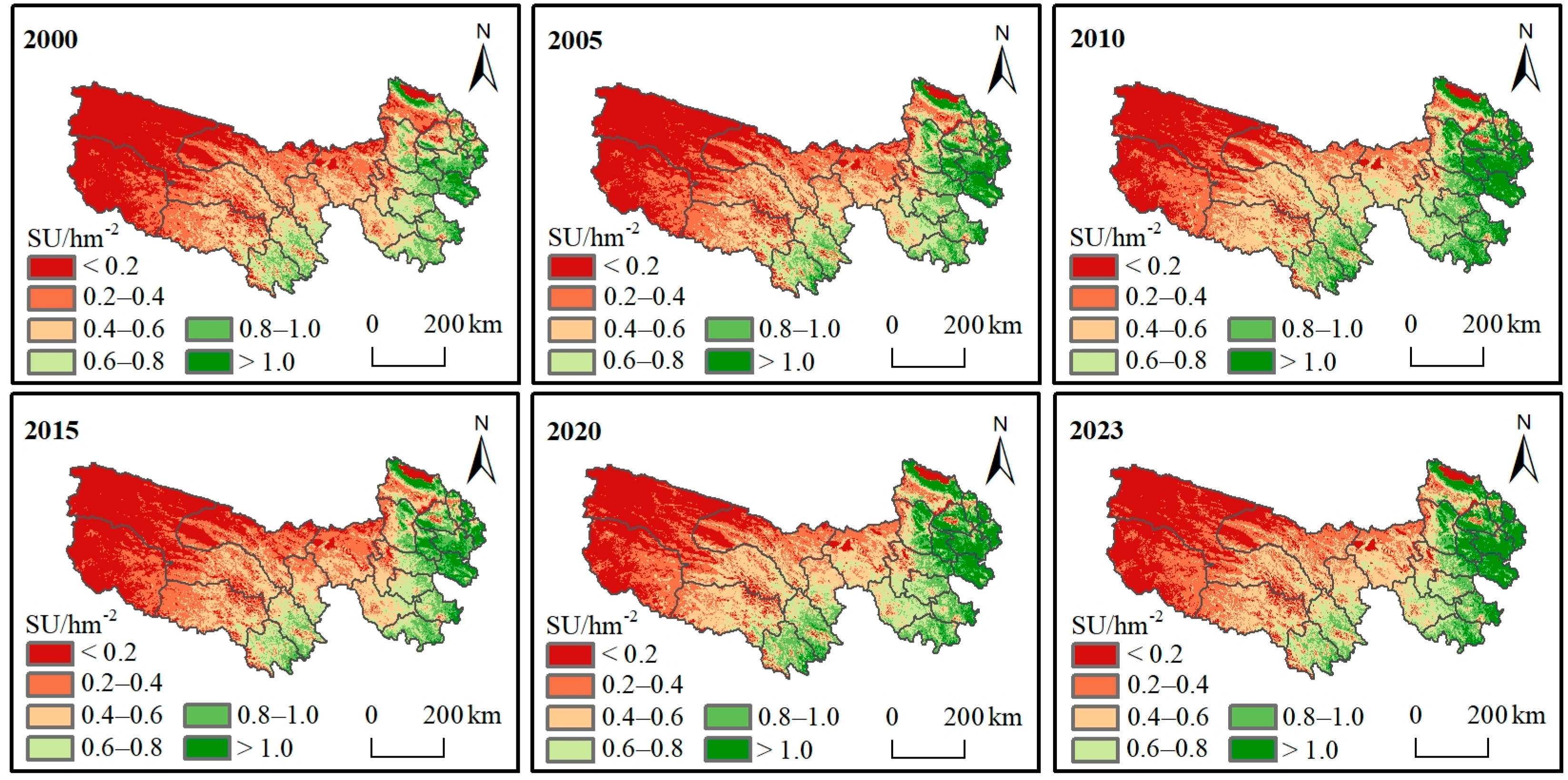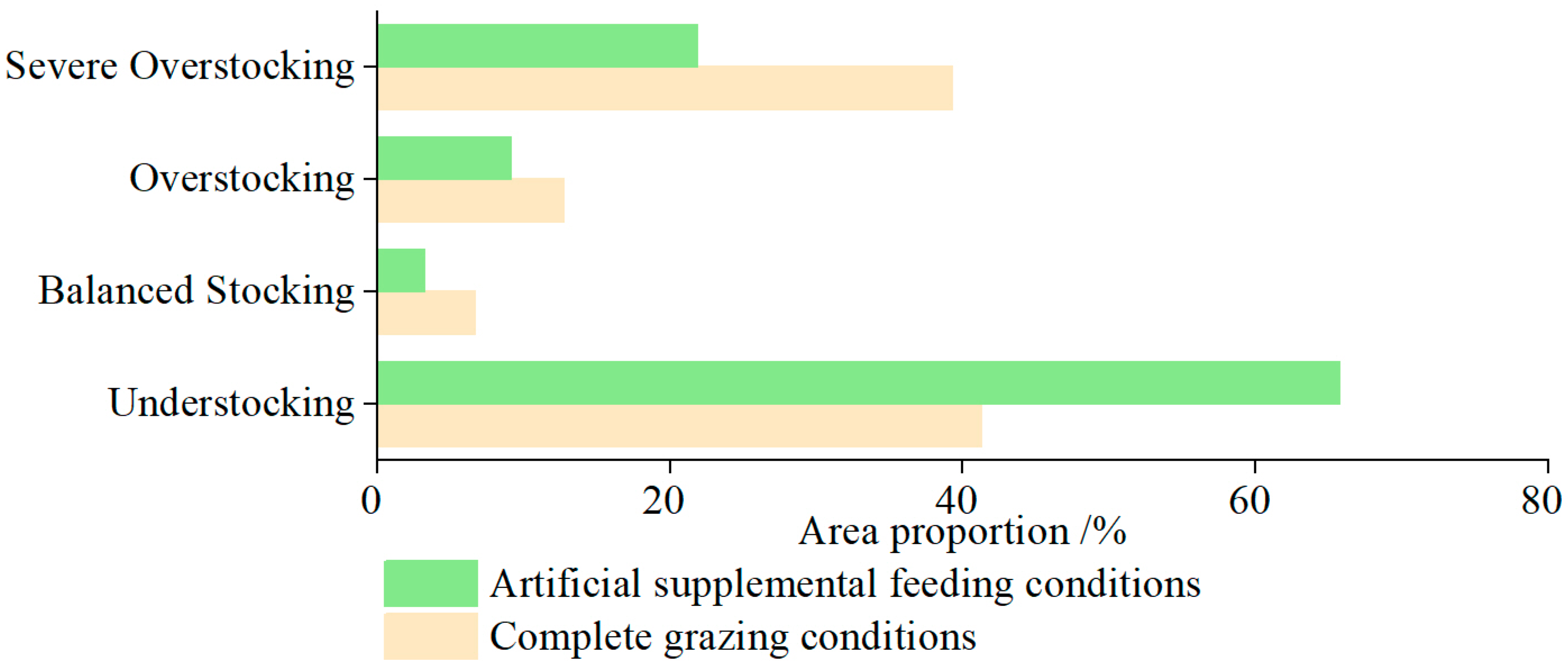Assessment of Grassland Carrying Capacity and Grass–Livestock Balance in the Three River Headwaters Region Under Different Scenarios
Simple Summary
Abstract
1. Introduction
2. Materials and Methods
2.1. Study Area
2.2. Data Sources
2.3. Research Methods
2.3.1. Grass Yield Calculation and Mann-Kendall (MK) Test
2.3.2. Calculation of Actual Livestock Carrying Capacity (CC)
2.3.3. Calculation of Theoretical Livestock Carrying Capacity (CC)
2.3.4. Calculation of Crude Protein Yield of Edible Forage
2.3.5. Calculation of Grass and Livestock Balance and Overgrazing Rate in Different Scenarios
2.3.6. Evaluation Grade Classification of Grass–Livestock Balance and Overgrazing Rate
3. Results
3.1. Analysis of Grass Yield
3.2. Temporal and Spatial Distribution of Actual Livestock Carrying Capacity (CC)
3.3. Spatial and Temporal Distribution of Theoretical Carrying Capacity (CC)
3.3.1. Theoretical Spatial and Temporal Distribution of Livestock Carrying Capacity (CC) Under Complete Grazing Conditions
3.3.2. Theoretical Crude Protein Carrying Capacity (CC) of Edible Pasture Under Nutrient Loading
3.4. Grass–Livestock Balance Under Different Scenarios
3.4.1. The Grass–Livestock Balance Under Complete Grazing Conditions
3.4.2. The Grass–Livestock Balance Under Artificial Supplementary Feeding Conditions
3.4.3. The Grass–Livestock Balance Under Nutrient Carrying Capacity (CC)
4. Discussion
4.1. Spatial and Temporal Distribution of Grass Yield and Supply–Demand Contradictions in the TRHR
4.2. The Balance of Grass and Livestock in the TRHR and the Impact of Artificial Supplementary Feeding on It
4.3. Influencing Factors and Limitations of Grassland Carrying Capacity (CC) Assessment
4.4. Recommendations for Improving Grassland Management
5. Conclusions
Author Contributions
Funding
Institutional Review Board Statement
Informed Consent Statement
Data Availability Statement
Acknowledgments
Conflicts of Interest
Abbreviations
| TRHR | Three River Headwaters Region |
| CC | carrying capacity |
| SU | sheep units |
| NPP | Net Primary Productivity |
| MK | Mann-Kendall |
References
- Ni, J. Estimating Net Primary Productivity of Grasslands from Field Biomass Measurements in Temperate Northern China. Plant Ecol. 2004, 174, 217–234. [Google Scholar] [CrossRef]
- Ali, I.; Cawkwell, F.; Dwyer, E.; Barrett, B.; Green, S. Satellite Remote Sensing of Grasslands: From Observation to Management. J. Plant Ecol. 2016, 9, 649–671. [Google Scholar] [CrossRef]
- Zhao, Y.J.; Song, W.J.; Wu, Z.S.; Bai, Y.F. Spatial and temporal analysis of reasonable livestock carrying capacity and ecological carrying capacity of grasslands in pastoral areas of China. Chin. Sci. Bull. 2024, 70, 1–16. [Google Scholar] [CrossRef]
- Xu, Z.; Li, X.; Zhang, L. Moderate Grazing Intensity and Pika Disturbance Can Enhance Plant Diversity and Soil Nutrient Cycling in the Alpine Grasslands of the Qinghai-Xizang Plateau. Ecol. Front. 2025, 45, 108–116. [Google Scholar] [CrossRef]
- Wang, Q.; Okadera, T.; Nakayama, T.; Batkhishig, O.; Bayarsaikhan, U. Estimation of the Carrying Capacity and Relative Stocking Density of Mongolian Grasslands under Various Adaptation Scenarios. Sci. Total Environ. 2024, 913, 169772. [Google Scholar] [CrossRef]
- Cai, Z.Y.; Wang, J.B.; Song, P.F.; Jiang, F.; Liang, C.B.; Zhang, J.J.; Gao, H.M.; Zhang, T.Z. The analysis of grazing pressure of ungulates on grassland in Lancang River Source Park, Sanjiangyuan National Park. Acta Ecol. Sin. 2025, 45, 1844–1853. [Google Scholar]
- Zhang, H.; Fan, J.; Wang, J.; Cao, W.; Harris, W. Spatial and Temporal Variability of Grassland Yield and Its Response to Climate Change and Anthropogenic Activities on the Tibetan Plateau from 1988 to 2013. Ecol. Indic. 2018, 95, 141–151. [Google Scholar] [CrossRef]
- Song, W.J.; Su, J.S.; Zhang, M.D.; Zhao, Y.J.; Wang, Z.W.; Jia, Y.S.; Bai, Y.F. Plant compensatory growth and optimal grazing intensity of grasslands in northern China: A meta-analysis of grazing experiments. Chin. Sci. Bull. 2023, 68, 1330–1342. [Google Scholar] [CrossRef]
- Gao, H.; Jiang, F.; Chi, X.; Li, G.; Cai, Z.; Qin, W.; Zhang, J.; Wu, T.; Zhang, T. The Carrying Pressure of Livestock Is Higher than That of Large Wild Herbivores in Yellow River Source Area, China. Ecol. Model. 2020, 431, 109163. [Google Scholar] [CrossRef]
- Xu, Q.; LI, Q.; Chen, D.d.; He, F.Q.; Chen, X.; Zhao, X.Q.; Zhao, L. The spatial-temporal characteristic of land use change in Sanjiangyuan Region and its effect factors. Ecol. Environ. Sci. 2017, 26, 1836–1843. [Google Scholar]
- Liu, J.; Xu, X.; Shao, Q. Grassland Degradation in the “Three-River Headwaters” Region, Qinghai Province. J. Geogr. Sci. 2008, 18, 259–273. [Google Scholar] [CrossRef]
- Shu, K.; Gao, X.; Qian, D.; Zhao, L.; Li, Q.; Dai, L. Relationship between Biomass and Biodiversity of Degraded Grassland in the Sanjiangyuan Region of Qinghai–Tibet Plateau. Diversity 2022, 14, 1002. [Google Scholar] [CrossRef]
- Tian, D.; Xie, Y.; Barnosky, A.D.; Wei, F. Defining the Balance Point between Conservation and Development. Conserv. Biol. 2019, 33, 231–238. [Google Scholar] [CrossRef]
- Ding, L.; Yan, Q.; Liu, P.; Yang, Q.; Henkin, Z.; Degen, A.A. Livestock Turnover and Dynamic Livestock Carrying Capacity Are Crucial Factors for Alpine Grassland Management: The Qinghai-Tibetan Plateau as a Case Study. J. Environ. Manag. 2024, 365, 121586. [Google Scholar] [CrossRef]
- Freeland, W.J.; Choquenot, D. Determinants of Herbivore Carrying Capacity: Plants, Nutrients, and Equus Asinus in Northern Australia. Ecology 1990, 71, 589–597. [Google Scholar] [CrossRef]
- Bai, Y.; Zhou, S.; Wu, J.; Zeng, H.; Luo, B.; Huang, M.; Qi, L.; Li, W.; Shrestha, M.; Degen, A.A.; et al. Estimation of Crude Protein Content in Revegetated Alpine Grassland Using Hyperspectral Data. Remote Sens. 2025, 17, 2114. [Google Scholar] [CrossRef]
- Qi, H.; Chen, A.; Yang, X.; Xing, X. Estimation of Crude Protein Content in Natural Pasture Grass Using Unmanned Aerial Vehicle Hyperspectral Data. Comput. Electron. Agric. 2025, 229, 109714. [Google Scholar] [CrossRef]
- Zhang, L.X.; Fan, J.W.; Shao, Q.Q.; Tang, F.P.; Zhang, H.y.; Li, Y.Z. Changes in grassland yield and grazing pressure in the Three Rivers headwater region before and after the implementation of the eco-restoration project. Acta Pratacult. Sin. 2014, 23, 116–123. [Google Scholar]
- Wang, S.X.; Xu, Z.R.; Qiao, T.; Zhang, B.; Wei, Z.Q.; Yang, X.M. Intensity of competition for forage between livestock and wild herbivores based on grassland carrying capacity. Prog. Geogr. 2023, 42, 2186–2197. [Google Scholar] [CrossRef]
- Wei, Q.; Zhou, B.; Wang, W. Qinghai Province (Tibetan Plateau): Quantifying the Influence of Climate Change and Human Activities on Vegetation Net Primary Productivity and Livestock Carrying Capacity Growth Potential. Biology 2025, 14, 494. [Google Scholar] [CrossRef] [PubMed]
- Zhang, X.; Ning, J. Patterns, Trends, and Causes of Vegetation Change in the Three Rivers Headwaters Region. Land 2023, 12, 1127. [Google Scholar] [CrossRef]
- Zhao, X.Q. Current Status, Changes, and Management of Ecosystems in Sanjiangyuan National Park; Science Press: Beijing, China, 2021. [Google Scholar]
- He, F.Q.; Chen, D.D.; Li, Q.; Huo, L.L.; Zhao, L.; Li, C.L.; Chen, X. Temporal and Spatial Patterns of Herbage and Nutrient Carrying Capacity of Alpine Grassland of Sanjiangyuan. Acta Agrest. Sin. 2021, 29, 2808–2816. [Google Scholar]
- Guo, B.; Zang, W.; Han, B.; Chen, S.; Liu, Y.; Yang, X.; He, T.; Chen, X.; Liu, C.; Gong, R. Spatial and Temporal Change Patterns of Net Primary Productivity and Its Response to Climate Change in the Qinghai-Tibet Plateau of China from 2000 to 2015. J. Arid Land 2020, 12, 1–17. [Google Scholar] [CrossRef]
- Lu, X.; Wang, J.L.; Kang, H.J.; Zhao, Q.; Han, X.H.; Wang, Y.J. Spatio-temporal Changes of Grassland Production Based on MODIS NPP in the Three-River Source Region from 2006 to 2015. J. Nat. Resour. 2017, 32, 1857–1868. [Google Scholar]
- Wang, C.Y.; Wang, J.B.; Zhang, F.W.; Li, Y.N.; Li, H.Q.; Yang, Y.S.; Luo, F.L. Climate resource utilization rate and livestock-carrying capacity of grasslands in the Three River Headwaters region over the past 40 years. Pratacultural Sci. 2022, 39, 672–687. [Google Scholar]
- Mo, X.G.; Liu, W.; Meng, C.C.; Hu, S.; Liu, S.X.; Lin, Z.H. Variations of forage yield and forage⁃livestock balance in grasslands over the Tibetan Plateau, China. Chin. J. Appl. Ecol. 2021, 32, 2415. [Google Scholar]
- Wang, Q.; Wu, Y.C.; Chen, K.L.; Zhang, X.; Zhang, L.L.; Ding, J.X. Estimating grassland yield and carrying capacity in Qinghai Lake Basin based on MODIS NPP data. Ecol. Sci. 2019, 38, 178–185. [Google Scholar]
- Fan, J.W.; Shao, Q.Q.; Wang, J.B.; Chen, Z.Q.; Zhong, H.P. An Analysis of Temporal-spatial Dynamics of Grazing Pressure on Grassland in Three Rivers Headwater Region. Chin. J. Grassland 2011, 33, 64–72. [Google Scholar]
- Xia, X.S.; Ma, G.X.; Che, H.Y.; Pan, Y.Z.; Huang, Y.S.; Li, H.D. Estimation and change analysis of forage-livestock balance based on cold and warm season grazing region division in Yushu Prefecture, China. Pratacultural Sci. 2024, 41, 1007–1019. [Google Scholar]
- Qian, Q.; Zhang, X.J.; Wang, J.B.; Ye, H.; Li, Y.N.; Zhang, Z.J. TheSpatio-temporalPatternofGrazingPressureintheThree-RiverHeadwaters in Qinghai Province from 2005 to 2017. Acta Agrest. Sin. 2021, 29, 1311–1317. [Google Scholar]
- Hao, L.Z.; Liu, S.J.; Wu, K.X.; Zhao, Y.P.; Zhang, X.W. Study on the Evaluation of Grass Nutrition and Carrying Capacity in Alpine Grassland of Kobresia hastily in Maduo County. Chin. J. Grassland 2011, 33, 84–89. [Google Scholar]
- Yuan, X.; Guo, B.; Lu, M. The Responses of Vegetation NPP Dynamics to the Influences of Climate–Human Factors on Qinghai–Tibet Plateau from 2000 to 2020. Remote Sens. 2023, 15, 2419. [Google Scholar] [CrossRef]
- Han, Z.; Song, W.; Deng, X.; Xu, X. Grassland Ecosystem Responses to Climate Change and Human Activities within the Three-River Headwaters Region of China. Sci. Rep. 2018, 8, 9079. [Google Scholar] [CrossRef]
- Zhang, X.; Jin, X. Vegetation Dynamics and Responses to Climate Change and Anthropogenic Activities in the Three-River Headwaters Region, China. Ecol. Indic. 2021, 131, 108223. [Google Scholar] [CrossRef]
- Cai, H.; Yang, X.; Xu, X. Human-Induced Grassland Degradation/Restoration in the Central Tibetan Plateau: The Effects of Ecological Protection and Restoration Projects. Ecol. Eng. 2015, 83, 112–119. [Google Scholar] [CrossRef]
- Zhang, L.; Fan, J.; Zhou, D.; Zhang, H. Ecological Protection and Restoration Program Reduced Grazing Pressure in the Three-River Headwaters Region, China. Rangel. Ecol. Manag. 2017, 70, 540–548. [Google Scholar] [CrossRef]
- Yang, T.; Dong, J.; Huang, L.; Li, Y.; Yan, H.; Zhai, J.; Wang, J.; Jin, Z.; Zhang, G. A Large Forage Gap in Forage Availability in Traditional Pastoral Regions in China. Fundam. Res. 2023, 3, 188–200. [Google Scholar] [CrossRef] [PubMed]
- Zhao, H.; Chang, J.; Havlík, P.; van Dijk, M.; Valin, H.; Janssens, C.; Ma, L.; Bai, Z.; Herrero, M.; Smith, P.; et al. China’s Future Food Demand and Its Implications for Trade and Environment. Nat. Sustain. 2021, 4, 1042–1051. [Google Scholar] [CrossRef]
- Dong, W.; Wang, X.; Yang, J. Future Perspective of China’s Feed Demand and Supply during Its Fast Transition Period of Food Consumption. J. Integr. Agric. 2015, 14, 1092–1100. [Google Scholar] [CrossRef]
- Wang, B.; Yan, H.; Zhang, Q. Reciprocity of Grassland Conservation and Pastoralist Livelihoods: Evidence from Comparison between Developed and Developing Regions. Ecol. Indic. 2022, 144, 109517. [Google Scholar] [CrossRef]
- Zhao, Z.; Bai, Y.; Deng, X.; Chen, J.; Hou, J.; Li, Z. Changes in Livestock Grazing Efficiency Incorporating Grassland Productivity: The Case of Hulun Buir, China. Land 2020, 9, 447. [Google Scholar] [CrossRef]
- Lu, H.Y.; Wang, J.; Li, H.P.; Zheng, H.X.; Miao, P. Calculation method and application of the tradeoff on water, land, forage, and livestock in family pasture considering forage quality. Trans. Chin. Soc. Agric. Eng. 2023, 39, 249–258. [Google Scholar]
- Fang, J.Y.; Bai, Y.F.; Li, L.H.; Jiang, G.M.; Huang, J.H.; Huang, Z.Y.; Zhang, W.H.; Gao, S.Q. Scientific basis and practical ways for sustainable development of China’s pasture regions. Chin. Sci. Bull. 2016, 61, 155. [Google Scholar]
- Zhou, L.; Wang, L.; Zhao, B.P.; Mi, J.Z.; Wang, F.W.; Liu, J.H.; Zang, D.; Liu, Y.K. Effect of different sowing date and cutting time on yield and quality of forage oat in agro-pastoral ecotone of northern China. Acta Agrest. Sin. 2021, 29, 2355–2363. [Google Scholar]
- Fang, J.Y.; Pan, Q.M.; Gao, S.Q.; Jing, H.Z.; Zhang, W.H. “Small vs. Large Area” Principle: Protecting and restoring a large area of natural grassland by establishing a small area of cultivated pasture. Pratacultural Sci. 2016, 33, 1913–1916. [Google Scholar]
- Zhang, J.; Zhang, L.; Liu, W.; Qi, Y.; Wo, X. Livestock-Carrying Capacity and Overgrazing Status of Alpine Grassland in the Three-River Headwaters Region, China. J. Geogr. Sci. 2014, 24, 303–312. [Google Scholar] [CrossRef]
- Bardgett, R.D.; Bullock, J.M.; Lavorel, S.; Manning, P.; Schaffner, U.; Ostle, N.; Chomel, M.; Durigan, G.; Fry, E.L.; Johnson, D.; et al. Combatting Global Grassland Degradation. Nat. Rev. Earth Environ. 2021, 2, 720–735. [Google Scholar] [CrossRef]
- Stampa, E.; Zander, K.; Hamm, U. Insights into German Consumers’ Perceptions of Virtual Fencing in Grassland-Based Beef and Dairy Systems: Recommendations for Communication. Animals 2020, 10, 2267. [Google Scholar] [CrossRef] [PubMed]
- Higgins, S.; Schellberg, J.; Bailey, J.S. Improving Productivity and Increasing the Efficiency of Soil Nutrient Management on Grassland Farms in the UK and Ireland Using Precision Agriculture Technology. Eur. J. Agron. 2019, 106, 67–74. [Google Scholar] [CrossRef]








| Classification | Overgrazing Rate |
|---|---|
| Understocking | B < 0 |
| Balanced Stocking | 0 ≤ B < 15% |
| Overstocking | 15% ≤ B < 50% |
| Severe Overstocking | B ≥ 50 |
| Period | Crude Protein Yield g/m−2 | Maintenance of Basic Metabolism SU/hm−2 | Maintenance of 45 kg Body Weight SU/hm−2 | Standard Sheep Body Weight Gain 100 g per Day SU/hm−2 |
|---|---|---|---|---|
| 2000 | 2.54 | 12.90 | 7.40 | 4.58 |
| 2005 | 2.78 | 14.11 | 8.09 | 5.00 |
| 2010 | 3.21 | 16.32 | 9.37 | 5.79 |
| 2015 | 2.67 | 13.56 | 7.78 | 4.81 |
| 2020 | 3.11 | 15.79 | 9.06 | 5.60 |
| 2023 | 3.02 | 15.36 | 8.81 | 5.45 |
| Grass–Livestock Balance and Overgrazing Rate | 2000 | 2005 | 2010 | 2015 | 2020 | 2023 |
|---|---|---|---|---|---|---|
| Maintenance of basic metabolism | −0.94 | −0.95 | −0.95 | −0.94 | −0.95 | −0.95 |
| Maintenance of 45 kg body weight | −0.90 | −0.91 | −0.92 | −0.90 | −0.91 | −0.90 |
| Standard sheep body weight gain 100 g per day | −0.84 | −0.85 | −0.86 | −0.83 | −0.85 | −0.85 |
| Maintenance of basic metabolism | −0.94 | −0.95 | −0.95 | −0.94 | −0.95 | −0.95 |
Disclaimer/Publisher’s Note: The statements, opinions and data contained in all publications are solely those of the individual author(s) and contributor(s) and not of MDPI and/or the editor(s). MDPI and/or the editor(s) disclaim responsibility for any injury to people or property resulting from any ideas, methods, instructions or products referred to in the content. |
© 2025 by the authors. Licensee MDPI, Basel, Switzerland. This article is an open access article distributed under the terms and conditions of the Creative Commons Attribution (CC BY) license (https://creativecommons.org/licenses/by/4.0/).
Share and Cite
Li, W.; Luo, Q.; Chen, Z.; Liu, Y.; Li, Z.; Wang, W. Assessment of Grassland Carrying Capacity and Grass–Livestock Balance in the Three River Headwaters Region Under Different Scenarios. Biology 2025, 14, 978. https://doi.org/10.3390/biology14080978
Li W, Luo Q, Chen Z, Liu Y, Li Z, Wang W. Assessment of Grassland Carrying Capacity and Grass–Livestock Balance in the Three River Headwaters Region Under Different Scenarios. Biology. 2025; 14(8):978. https://doi.org/10.3390/biology14080978
Chicago/Turabian StyleLi, Wenjing, Qiong Luo, Zhe Chen, Yanlin Liu, Zhouyuan Li, and Wenying Wang. 2025. "Assessment of Grassland Carrying Capacity and Grass–Livestock Balance in the Three River Headwaters Region Under Different Scenarios" Biology 14, no. 8: 978. https://doi.org/10.3390/biology14080978
APA StyleLi, W., Luo, Q., Chen, Z., Liu, Y., Li, Z., & Wang, W. (2025). Assessment of Grassland Carrying Capacity and Grass–Livestock Balance in the Three River Headwaters Region Under Different Scenarios. Biology, 14(8), 978. https://doi.org/10.3390/biology14080978







